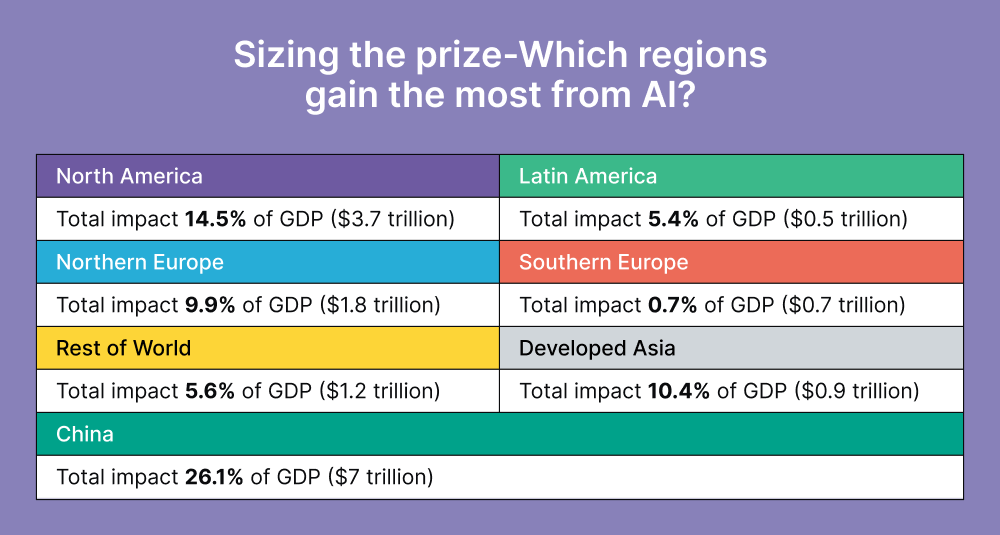32 Software Testing Statistics for Your Presentation in 2024
One of the best ways to understand software testing is to dig into its statistics. From defect detection rates to methodology adoption rates, embraced by industry leaders, these statistics serve as a compass, guiding software developers, testers, and stakeholders through the intricacies of quality assurance. Let’s begin!
Arrange a discovery call today to learn how we can help your business make high-quality products
Software testing industry statistics you should know about
In software development, the software testing industry is the guardian of quality, reliability, and functionality in applications and systems. Below are some of our favorite bits of evidence to support this – whether you’re building a presentation or preparing for an interview.- The software testing industry has smashed through the $45 billion milestone in market size, underscoring its pivotal role.
- The software testing market is steadily climbing, with a projected Compound Annual Growth Rate (CAGR) of 5% from 2023 to 2027.
- The banking, financial services, and insurance sectors take the lead in the European software testing landscape, constituting a substantial 28.5% share.
- Looking ahead, the global software testing market is gearing up for an impressive reach, projected to hit a whopping $109.5 billion by 2027.
- Automation testing is stealing the show, with forecasts pointing to a remarkable value of $68 billion by 2025, marking a significant milestone in its growth trajectory.
- Quality Assurance (QA) is taking center stage in development budgets, with an expected allocation of approximately 40% of the overall cost.
- These stats paint a vivid picture of a thriving industry, steering the course of software testing into an era of unprecedented growth and influence.
- The global software testers ratio is 5.2 per capita per 100,000 individuals. Leading the pack is Ireland, claiming the top spot with an impressive 61.2 software testers per 100,000 people. Following closely, the United States and Canada share the second position, each boasting 37.1 software testers per 100,000 individuals. Not far behind is Israel, registering 36.5 testers per 100,000 people.
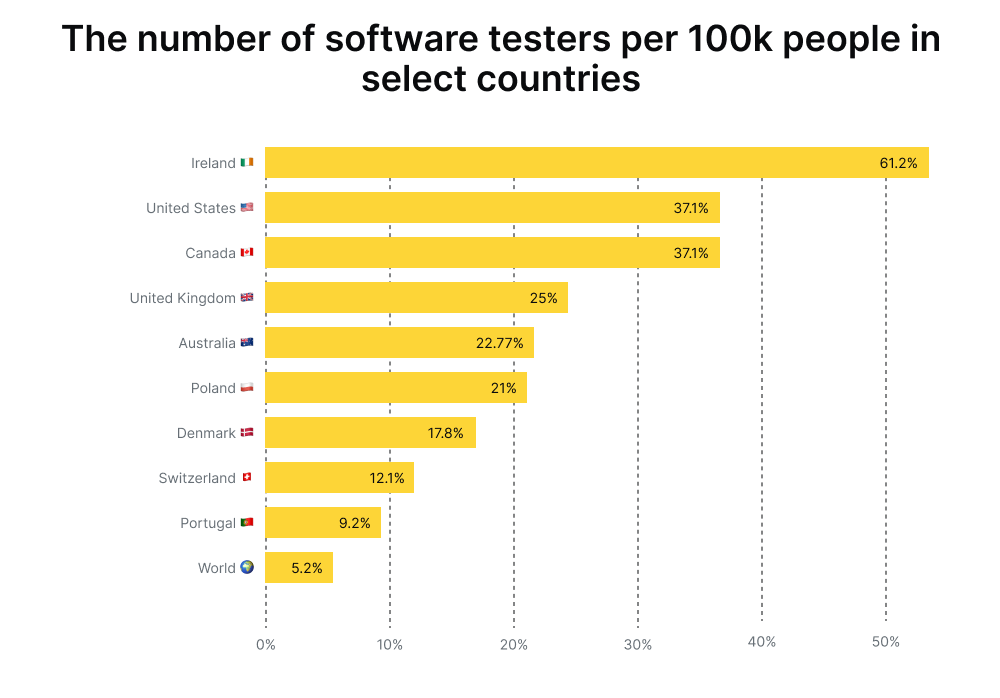
- The boost in QA budgets is credited by 52% of IT teams due to the growing number of releases. For sustained customer retention, constant improvement and development are non-negotiable. The expanding digital revolution demands the integration of new test cycles.
Test automation statistics
We all know software tests can be manual or automated. While certain manual testing types, like discovery and usability testing, hold significant value, tasks such as regression and functional testing can become inefficient when repeatedly performed manually. The repetitive nature of these tests makes them ideal candidates for automation, eliminating the need for humans to execute the same tasks redundantly.
- Expenditure on cybersecurity is poised to surpass $133.7 billion in 2022. The ongoing threat of data breaches necessitates frequent testing of security systems against emerging risks. Similarly, the projected growth of the global mobile application market to $407.31 billion by 2026 underscores the significance of testing, with big data further contributing to the demand for automated testin10. In 2020, 44% of IT organizations automated 50% of their testing or more. A further study identified that automated test cases constitute 50% of test cases in nearly half of RWS surveyed companies.
(The advantages of test automation include the execution of repetitive tasks, quicker bug identification, precision, and continuous feedback. These factors collectively save time and cost, leading to a more efficient software testing budget. - About one-quarter of companies that invested in test automation agreed that their ROI was “immediate.” 24% of companies. A further 24% reported an increase in ROI within the first six months, while 28% reached a positive ROI within a year. Just 9% of respondents reported unsuccessful outcomes
- A mere 5% of companies engage in fully automated testing. Two-thirds of software development companies employ testing in a 75:25 (manual: automation) ratio or 50:50. Solely 9% of survey respondents exclusively perform manual testing. Looking ahead, up to 73% aim to achieve a 50:50 or 25:75 balance, and around 14% aspire to eliminate manual testing entirely.
- Quality assurance testing statistics reveal six common roles in QA. Given the diverse testing needs requiring different expertise, the primary employee software testing roles include Test engineer, Test Manager, Test Automation Engineer, Software Developer Engineer in Test, Test Architect, Test Manager
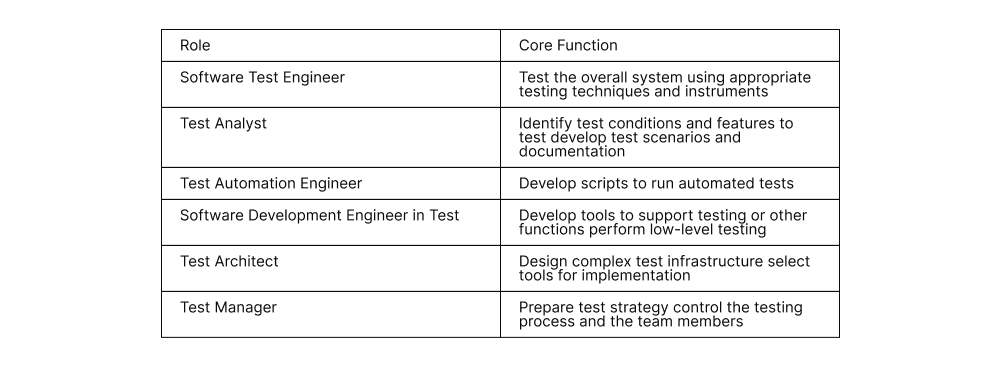
- There are 11 pivotal test automation metrics. As outlined in The SeaLights test metrics guide, these include total test duration, unit coverage, path coverage, requirements coverage, pass/fail test percentage, test case execution percentage, irrelevant results, defects in production, percentage of broken builds
- Exploratory testing is widely employed, with 82% of companies using this methodology, while 61% adhere to conventional scripting.
- While 35% of companies occasionally engage non-testers in the software testing process, 55% rely predominantly on dedicated software testers.
- In 2019, only 18% of testers intentionally pursued a career in software testing through formal education. 65% of survey respondents learned software testing through practical experience, emphasizing learning by doing.
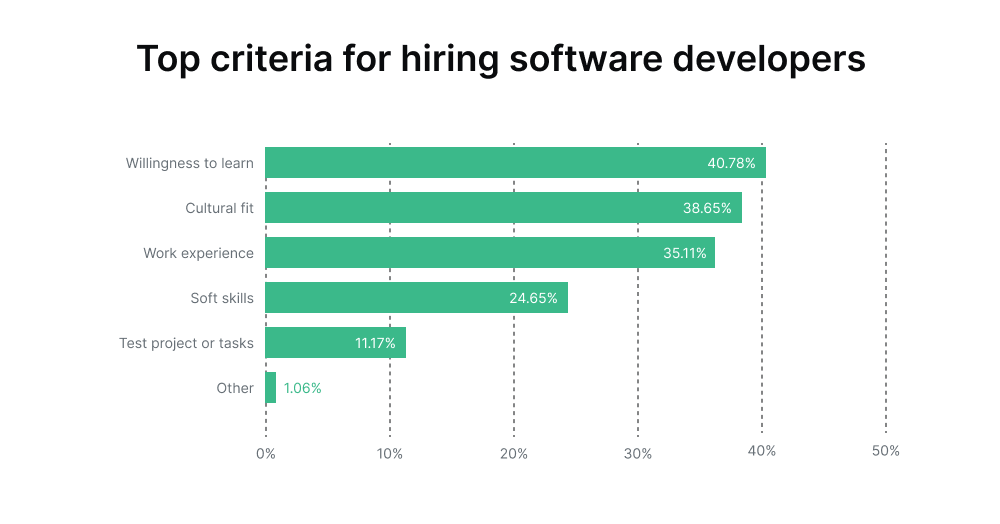
- Employment opportunities in software development, quality assurance, and testing are projected to grow by 22% from 2020 to 2030, surpassing the average growth rate for all occupations.
Popular software testing tools statistics
In the quest to deliver top-notch software products and stay ahead in a competitive landscape, the choice of effective software testing tools has evolved into a key decision.
These tools play a crucial role in aiding software development teams by pinpointing and resolving defects, ensuring application reliability, and streamlining the overall testing procedure.
- Bug reports emerge as the most commonly used testing documentation, with around 47% of testers relying on testing or QA tools such as HP ALM, PractiTest, Xray, and Team Foundation Server to address their testing requirements.
- Approximately 44% of developers regularly utilize issue tracker solutions, with Jira leading the pack as the preferred tool for 68% of developers. GitHub secures a second-place preference at 26%, followed by Trello at 19%. Other noteworthy tools include GitLab Issue Board (14%), Redmine (10%), Microsoft TFS (9%), YouTrack (7%), and Asana (4%).
- Notably, around 37% of YouTrack users boast more than 11 years of professional experience.
- A substantial 44% of IT companies have integrated automation into 50% of their testing processes, highlighting the prevalence of automated testing practices.
- Despite the advancements in technology, only 44% of contemporary companies have incorporated A/B testing software into their operations, indicating potential areas for increased utilization.
Demographic Snapshot of Software Testers
The diverse qualifications and demographics underscore the multifaceted nature of software testers' roles. Their meticulous testing procedures, encompassing both manual and automated testing methodologies, play a crucial role in ensuring software quality before deployment.
- Among software testers, 37.9% are female, while the majority, constituting 62.1%, are male.

- The demographic breakdown reveals that 67.7% of software testers belong to the White ethnicity, with 12.0% identifying as Asian and 8.8% as Hispanic or Latino.
- The average age of software testers is 40+, representing 62% of the tester population.
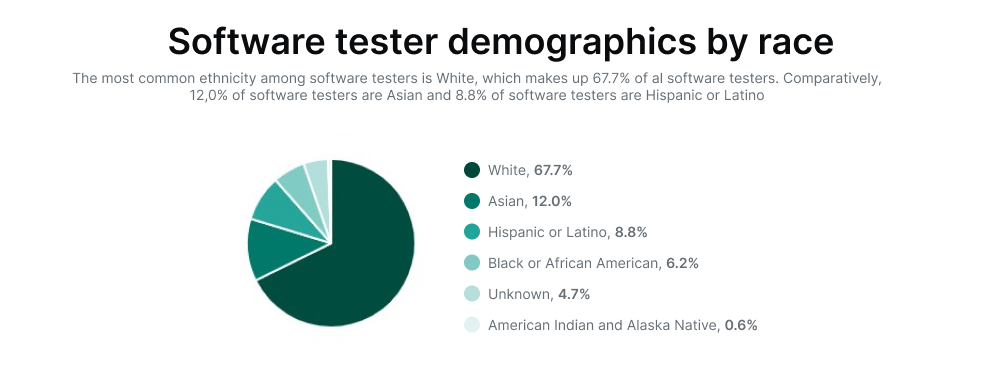
- Bachelor's degrees are the predominant qualification held by 68% of software testers.
Master's degrees follow closely, with 14% and 12% possessing a Doctorate degree.
Those with a Doctorate degree have the highest annual income at $88,707, followed by Master's degree holders at $88,344 and those with a Bachelor's degree at $81,661.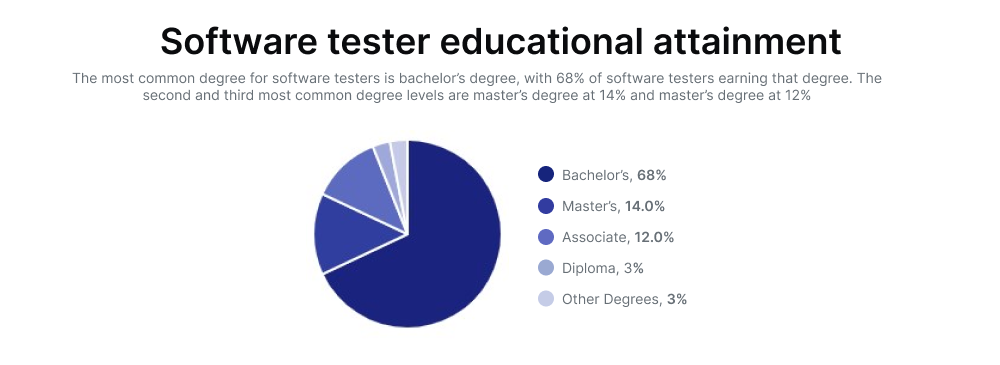
- Spanish is the primary second language software testers speak, with 31.2% proficient in it. French ranks second at 12.2%, and German takes the third spot at 11.2%.
2024 trends in software testing
As organizations pursue faster and more efficient solutions for developing high-quality software, the software testing landscape continues to evolve. The following trends highlight the latest developments in software testing:
- According to Forbes, Artificial Intelligence (AI) is poised for a 37.3% growth in usage from 2023 to 2030. While still in its early stages, AI and machine learning present a significant opportunity in testing.
- TestingXperts and Software Testing Help reported that 54% of developers are turning to DevOps for faster development cycles. DevOps minimizes the development-to-operations duration, allowing swift releases of products to the public.
- The expanding Internet of Things (IoT) trend prompts a shift in software testing towards IoT testing. With over 10% of venture capital funding directed to IoT, substantial growth is expected in this domain.
- Software Testing Help and Bytebeam report that 30% of developers favor test automation over manual testing. Automated testing, known for its speed, significantly reduces development time, leading to quicker and more efficient testing processes.
Conclusion
Software development and testing have undergone a transformative journey, progressing from manual testing to automated integrations. Developers are continually exploring avenues to enhance software development, contributing to the overall improvement of the market.
Emphasizing the importance of software testing and quality assurance is crucial to ensuring the delivery of high-quality products to a global audience.
How does Global App Testing help?
You may have diverse testing needs based on your priorities, such as ensuring app functionality across devices and validating software performance. No matter what you want to focus on, Global App Testing offers different solutions:
- Functional Testing: Validates app tasks, including security and UI.
- Exploratory Testing: Ad hoc bug identification within 36 hours.
- Regression Testing: Ensures changes don't impact existing features.
- Test Case Execution: Focuses on source code functionality.
- Usability Testing: Assesses real-world performance for end-users.
- Web App Testing: Evaluates quality and supports security.
- Mobile App Testing: Tests on actual devices, quick issue resolution.
- Localized App Testing: Ensures global compliance in 189+ countries.
- Test Analysis: Clear reports integrated with bug trackers.
Let us arrange a discovery call and see how we can help your product shine!
We can help you to effectively test your software and keep it aligned to your business goals
Keep learning
Lessons from the alignment: using global data more effectively
Our finding: businesses localize in the dark
How can testing support inclusive design?


